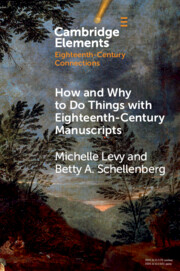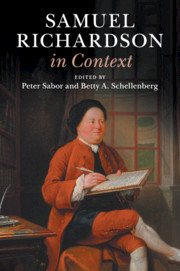69 results

How and Why to Do Things with Eighteenth-Century Manuscripts
-
- Published online:
- 19 November 2021
- Print publication:
- 16 December 2021
-
- Element
-
- You have access
- Open access
- HTML
- Export citation
Chapter 27 - The Bluestockings
- from Legal and Social Culture
-
-
- Book:
- Mary Wollstonecraft in Context
- Published online:
- 16 January 2020
- Print publication:
- 06 February 2020, pp 230-237
-
- Chapter
- Export citation
Chapter 9 - The Eighteenth Century
- from Part I - Historical Perspectives
-
-
- Book:
- The Cambridge Handbook of Literary Authorship
- Published online:
- 07 June 2019
- Print publication:
- 06 June 2019, pp 133-146
-
- Chapter
- Export citation
Index
-
- Book:
- Samuel Richardson in Context
- Published online:
- 21 September 2017
- Print publication:
- 21 September 2017, pp 327-348
-
- Chapter
- Export citation
Chapter 11 - Authorship
- from Part III - The Print Trade
-
-
- Book:
- Samuel Richardson in Context
- Published online:
- 21 September 2017
- Print publication:
- 21 September 2017, pp 91-99
-
- Chapter
- Export citation
Contents
-
- Book:
- Samuel Richardson in Context
- Published online:
- 21 September 2017
- Print publication:
- 21 September 2017, pp i-iv
-
- Chapter
- Export citation
Preface
-
- Book:
- Samuel Richardson in Context
- Published online:
- 21 September 2017
- Print publication:
- 21 September 2017, pp xi-xviii
-
- Chapter
- Export citation
Part II - Critical Fortunes
-
- Book:
- Samuel Richardson in Context
- Published online:
- 21 September 2017
- Print publication:
- 21 September 2017, pp 26-34
-
- Chapter
- Export citation
Notes on Contributors
-
- Book:
- Samuel Richardson in Context
- Published online:
- 21 September 2017
- Print publication:
- 21 September 2017, pp ix-x
-
- Chapter
- Export citation
Chronology
-
- Book:
- Samuel Richardson in Context
- Published online:
- 21 September 2017
- Print publication:
- 21 September 2017, pp xxiii-xxx
-
- Chapter
- Export citation

Samuel Richardson in Context
-
- Published online:
- 21 September 2017
- Print publication:
- 21 September 2017
Abbreviations
-
- Book:
- Samuel Richardson in Context
- Published online:
- 21 September 2017
- Print publication:
- 21 September 2017, pp xxiii-xxx
-
- Chapter
- Export citation
Illustrations
-
- Book:
- Samuel Richardson in Context
- Published online:
- 21 September 2017
- Print publication:
- 21 September 2017, pp v-viii
-
- Chapter
- Export citation
Part VI - Social Structures and Social Life
-
- Book:
- Samuel Richardson in Context
- Published online:
- 21 September 2017
- Print publication:
- 21 September 2017, pp 213-220
-
- Chapter
- Export citation
Acknowledgments
-
- Book:
- Samuel Richardson in Context
- Published online:
- 21 September 2017
- Print publication:
- 21 September 2017, pp xix-xxi
-
- Chapter
- Export citation
Part III - The Print Trade
-
- Book:
- Samuel Richardson in Context
- Published online:
- 21 September 2017
- Print publication:
- 21 September 2017, pp 72-80
-
- Chapter
- Export citation
Further Reading
-
- Book:
- Samuel Richardson in Context
- Published online:
- 21 September 2017
- Print publication:
- 21 September 2017, pp 319-326
-
- Chapter
- Export citation
Part IV - The Book and Its Readers
-
- Book:
- Samuel Richardson in Context
- Published online:
- 21 September 2017
- Print publication:
- 21 September 2017, pp 108-116
-
- Chapter
- Export citation
Part V - Literary Genres and the Arts
-
- Book:
- Samuel Richardson in Context
- Published online:
- 21 September 2017
- Print publication:
- 21 September 2017, pp 136-144
-
- Chapter
- Export citation
Part I - Life and Works
-
- Book:
- Samuel Richardson in Context
- Published online:
- 21 September 2017
- Print publication:
- 21 September 2017, pp xxxi-xxxii
-
- Chapter
- Export citation



